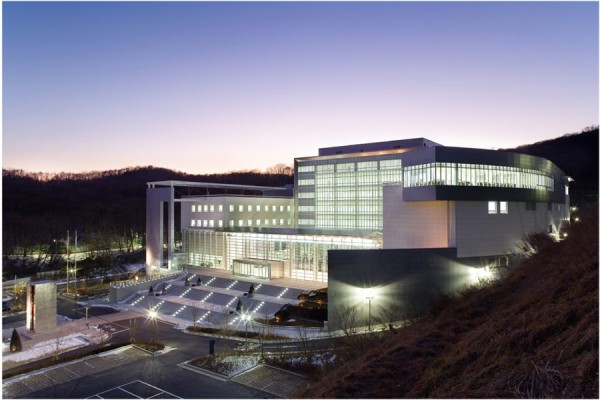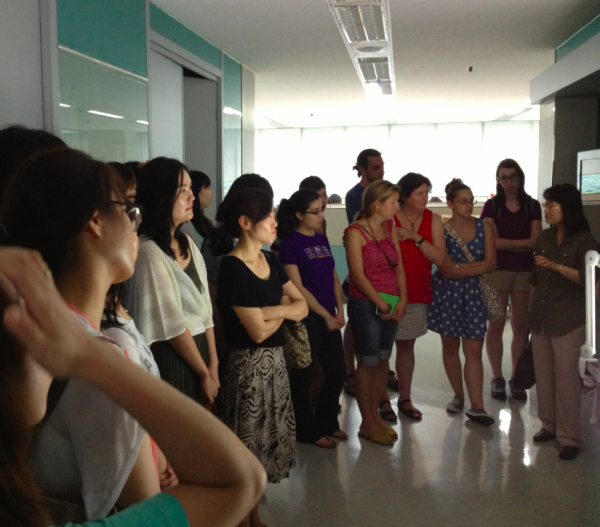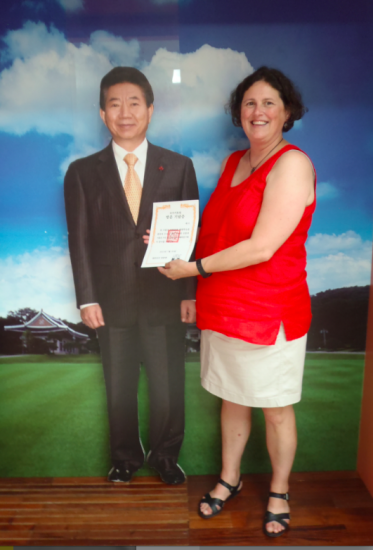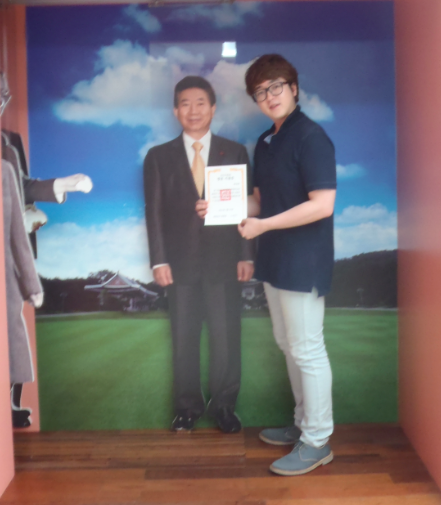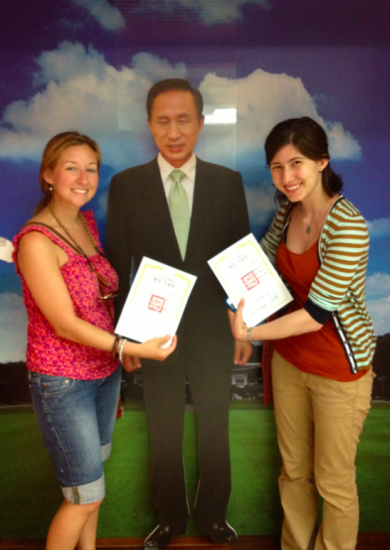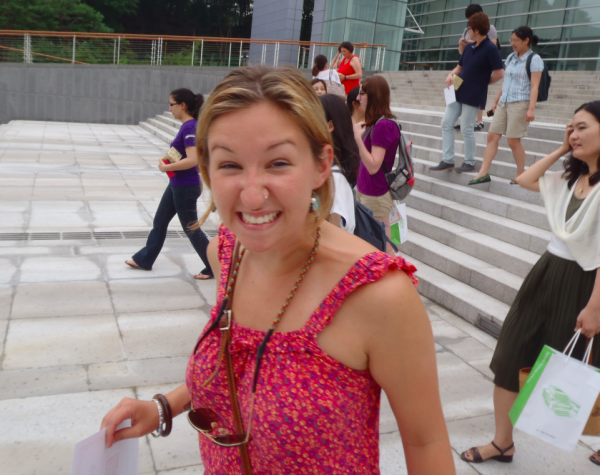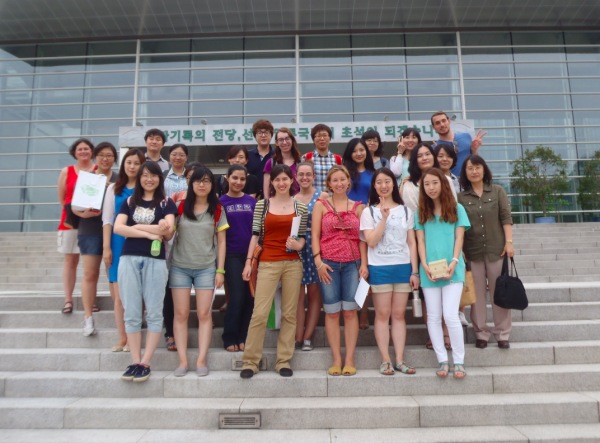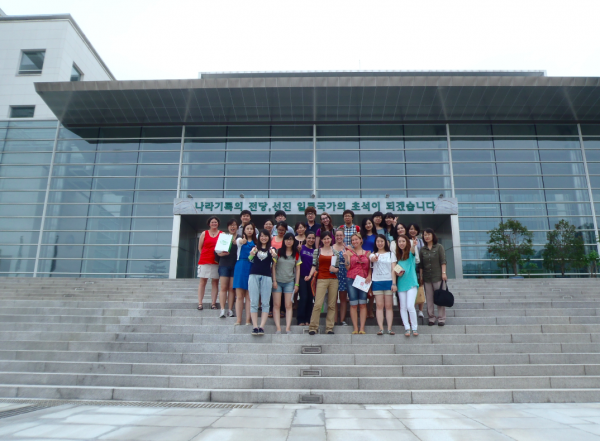Greetings from the surface of the sun – i.e. Seoul. Per usual this time of year, the weather here is insufferably hot. However, that has not been a deterrent for our adventurous group of GSLIS students who are eager see as much of this incredible city as possible in the short time we have here.
Yesterday, we were lucky enough to receive a private tour of the National Archives of Korea in Seoul. As we learned, South Korea has 5 locations for its National Archives, with one of the largest being just an hour from Yonsei University campus. This tour was particularly special for us because our Korean colleagues joined us on this journey, as most of them had never visited the National Archives. They were just as curious and excited as our students, and the overall enthusiasm level exceedingly high.
We began our tour on the fifth floor of this beautiful building:
As our guide explained, this particular building was built both visually and physically around the idea of protecting the national heritage embodied by the Presidential Archives Collection – the collection housed at this specific location. As you see from the photo, the building consists of three main parts: the center rectangle protecting the stacks, the right wing which serves as a visitor education center, and the left wing, where all of the magic happens in offices and labs. The idea is that visually, the two wings flanking the center protect, or “hug,” the valuable treasures stored within the building’s center. Also, the two outer wings are filled with those individuals entrusted by the government to preserve, protect, and maintain the important objects stored here. The entire facility was absolutely beautiful and the individual offices and labs were some of the nicest work spaces I’ve ever seen in a repository type setting.
The fifth floor is home to the team responsible for microfilming and duplicating certain collections within the Presidential Archives. In a low-lit room, we found seven staff members diligently copying papers onto microfilm – with each staff member completing an average of one roll per day, equalling about 2,000 slides. WOW! We were all amazed at how much work is completed on a daily basis in just this one small room, with such intense commitment to detail.
We were also allowed entry into the dark room, where the microfilm collections are duplicated, so that a copy can be sent to the 4 other National Archives location in South Korea. Outside the dark room, all of the copies are tested for potential error, and then prepared for storage or shipment. Needless to say, Professor Wisser was most curious about which collections were selected for microfilm, and whether or not many of those collections would also be digitized. Interestingly enough, the answer was very similar to what we expected would be the answer for American repositories. In short, the answer was that there is still a lot of hesitation about the permanence of the digital form. They still undertake tremendous effort to make many of their collections available digitally, but take extra precautions to also save many, more important collections on microfilm to ensure that they will not disappear when and if the digital format becomes obsolete or no longer relevant. From this answer, we ascertained that a lot of the discussions, debates and concerns we have in American repositories, are very much felt with equal concern, and often confusion, in Korea as well. Here we are trying to learn more:
On the fourth floor, there is small exhibit space displaying old recording devices and film cleaning machines that have become obsolete. After this interesting exhibit, in which the guide quizzed us on what we thought the objects might have been used for, we were given a tour of offices and labs used for multimedia. This is where film collections are cleaned, duplicated, remastered, mixed, and/or complete restored if necessary. Photo collections are also touched up here to clear up images that are dirty, damaged, or difficult to use.
The third floor was home to one of the most high-tech and innovative preservation laboratories I’ve ever seen. There are several preservation specialists and conservators hard at work delicately repairing damaged objects, and actually REPRODUCING identical copies of certain objects for use in museums and other cultural heritage sites. In Korea, there is a state law that makes it illegal to remove objects or documents from the National Archives as they have been deemed the utmost importance for collective memory, national accountability, and democracy. For that reason, elaborate reproductions of objects are created in the preservation labs so that museums, palaces, and libraries display them to their patrons. We were able to look at a 2000 year old text that had been recently reproduced, and would not have been able to tell which was the original, and which was the copy. Needless to say, we were stunned that all of the pieces we have been viewing in palaces the past few days, were all reproductions.
For the last part of the tour, we were taken to a room that was actually an elaborate reproduction of the actual stacks. Only few people with high security clearance are allowed into the stacks (not even our guide had permission to enter the actual stacks), so the Archives created a mock room for visitors to understand the high level security system they use to secure the materials, and to learn how they are stored for environmental precautions.
Every single folder in their collection is accompanied by an RFID. If access is not previously granted to an archivist to remove a specific collection from the stacks, the RFID will send a signal to lock down the entire building if a folder has been removed from its location.The building will not unlock, and no one can leave until the collection has been found and returned to its original location. Additionally, security cameras constantly monitor the number of archivists allowed in the stacks to ensure that no more than three people at a time enter the space – taking up 5 floors in over 24 separate rooms. As expected, the stacks are climate controlled and inert gas pipes line the ceilings in case of fire.
To end the tour, we were taken to an education exhibit for visitors to learn more about the archives, their mission, and some of the unique work they have been undertaking. There was also a fantastic display of objects gifted to the Korean Presidents over the past fifty years. At the end of the tour, we received a certificate of completion and got to take a photo with the Korean President of our choice. Check out Professor Wisser getting cozy with the previous President here:
And one very happy and satisfied archives student here:
Needless to say, we were all absolutely thrilled to be given such an incredible opportunity, and cannot express enough gratitude. What an excellent day!
